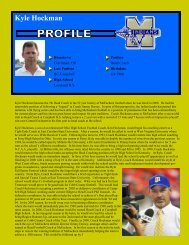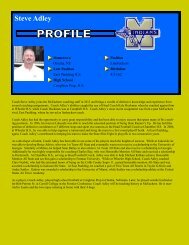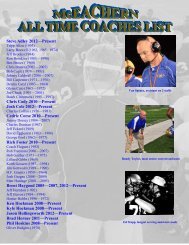Civilization Case Study: Ur in Sumer - McEachern High School
Civilization Case Study: Ur in Sumer - McEachern High School
Civilization Case Study: Ur in Sumer - McEachern High School
Create successful ePaper yourself
Turn your PDF publications into a flip-book with our unique Google optimized e-Paper software.
© McDougal Littell Inc. All rights reserved.<br />
Name ______________________________________________________________ Date ______________________<br />
CHAPTER 1 Section 3 (pages 19–23)<br />
<strong>Civilization</strong> <strong>Case</strong> <strong>Study</strong>:<br />
<strong>Ur</strong> <strong>in</strong> <strong>Sumer</strong><br />
BEFORE YOU READ<br />
In the last section, you read about the development<br />
of agriculture and a settled way of life.<br />
In this section, you will read about factors lead<strong>in</strong>g<br />
to the rise of civilizations.<br />
AS YOU READ<br />
Use the chart below to take notes on how<br />
civilizations develop.<br />
FEATURES OF CIVILIZATION EXAMPLES FROM UR<br />
1. Advanced Cities<br />
2.<br />
3.<br />
4.<br />
5.<br />
Villages Grow <strong>in</strong>to Cities (pages 19–20)<br />
What changed as vi1lages grew<br />
<strong>in</strong>to cities?<br />
Over time, farmers developed new tools—hoes,<br />
sickles, and plow sticks. These helped them grow<br />
even more food. They decided to plant larger areas<br />
of land. The people <strong>in</strong> some villages began to irri-<br />
TERMS AND NAMES<br />
civilization Culture with advanced<br />
cities, specialized workers, complex<br />
<strong>in</strong>stitutions, record keep<strong>in</strong>g, and<br />
improved technology<br />
specialization Development of skills<br />
<strong>in</strong> a specific k<strong>in</strong>d of work<br />
artisan Skilled worker that makes<br />
goods by hand<br />
<strong>in</strong>stitution Long-last<strong>in</strong>g pattern of<br />
organization <strong>in</strong> a community<br />
scribe Professional record keeper<br />
cuneiform Wedge-shaped writ<strong>in</strong>g<br />
developed <strong>in</strong> <strong>Sumer</strong><br />
Bronze Age Time when people began<br />
us<strong>in</strong>g bronze<br />
barter Trad<strong>in</strong>g goods and services<br />
without money<br />
ziggurat Pyramid-shaped monument;<br />
part of a temple <strong>in</strong> <strong>Sumer</strong><br />
gate the land, br<strong>in</strong>g<strong>in</strong>g water to new areas. People<br />
<strong>in</strong>vented the wheel for carts and the sail for boats.<br />
These new <strong>in</strong>ventions made it easier to travel<br />
between distant villages and to trade.<br />
Life became more complex as the villages<br />
began to grow. People were divided <strong>in</strong>to social<br />
classes. Some people had more wealth and power<br />
than others. People began to worship gods and<br />
CHAPTER 1 THE PEOPLING OF THE WORLD 9
goddesses that they felt would protect their crops<br />
and make their harvests large.<br />
1. How did life become more complex?<br />
How <strong>Civilization</strong> Develops (pages 20–21)<br />
What makes a civilization?<br />
One of the first civilizations arose <strong>in</strong> <strong>Sumer</strong>. It<br />
was <strong>in</strong> Mesopotamia, between the Tigris and<br />
Euphrates rivers of modern Iraq. A civilization<br />
has five features.<br />
First, a civilization has advanced cities that conta<strong>in</strong><br />
many people and serve as centers for trade.<br />
Second, civilizations have specialized workers.<br />
Specialization is the development of skills needed<br />
for one specific k<strong>in</strong>d of work. Skilled workers who<br />
make goods by hand are called artisans.<br />
Third, civilizations have complex <strong>in</strong>stitutions.<br />
Government, organized religion, and an economy<br />
are examples of complex <strong>in</strong>stitutions.<br />
A fourth feature of civilizations is record keep<strong>in</strong>g,<br />
which is needed to keep track of laws, debts,<br />
and payments. It also creates the need for writ<strong>in</strong>g.<br />
Scribes were people who used writ<strong>in</strong>g to keep<br />
records. Cuneiform, which means “wedge<br />
shaped,” was a form of writ<strong>in</strong>g <strong>in</strong>vented <strong>in</strong> <strong>Sumer</strong>.<br />
Fifth, civilizations have improved technology<br />
that can provide new tools and methods to solve<br />
problems.<br />
<strong>Sumer</strong> had all the features of a civilization. One<br />
of the new technologies <strong>in</strong> <strong>Sumer</strong> was mak<strong>in</strong>g a<br />
metal called bronze. The term Bronze Age refers<br />
to the time when people began us<strong>in</strong>g bronze to<br />
make tools and weapons.<br />
Analyz<strong>in</strong>g Key Concepts: <strong>Civilization</strong><br />
<strong>Civilization</strong> is def<strong>in</strong>ed as a complex culture with<br />
five characteristics—advanced cities, specialized<br />
workers, complex <strong>in</strong>stitutions, record<br />
keep<strong>in</strong>g, and improved technology.<br />
10 CHAPTER 1 SECTION 3<br />
2. Name the five features of a civilization.<br />
<strong>Civilization</strong> Emerges <strong>in</strong> <strong>Ur</strong><br />
(pages 22–23)<br />
What was civilization like <strong>in</strong> <strong>Ur</strong>?<br />
One of the early cities of <strong>Sumer</strong> was named <strong>Ur</strong>.<br />
The city was surrounded by walls built of mud<br />
dried <strong>in</strong>to bricks. <strong>Ur</strong> held about 30,000 people.<br />
Social classes <strong>in</strong>cluded rulers and priests, traders,<br />
craft workers, and artists.<br />
Farmers outside the city walls raised the food<br />
for them all. Some workers dug ditches to carry<br />
water to the fields. Officials of the city government<br />
planned all this activity.<br />
Inside the city, metalworkers made bronze<br />
po<strong>in</strong>ts for spears. Potters made clay pots. Traders<br />
met people from other areas. They traded the<br />
spear po<strong>in</strong>ts and pots for goods that <strong>Ur</strong> could not<br />
produce. This way of trad<strong>in</strong>g goods and services<br />
without money is called barter. Sometimes their<br />
deals were written down by scribes.<br />
<strong>Ur</strong>’s most important build<strong>in</strong>g was the temple.<br />
Part of the temple was a ziggurat, a pyramidshaped<br />
structure. Priests there led the city’s religious<br />
life.<br />
3. What social classes existed <strong>in</strong> <strong>Ur</strong>?<br />
© McDougal Littell Inc. All rights reserved.







